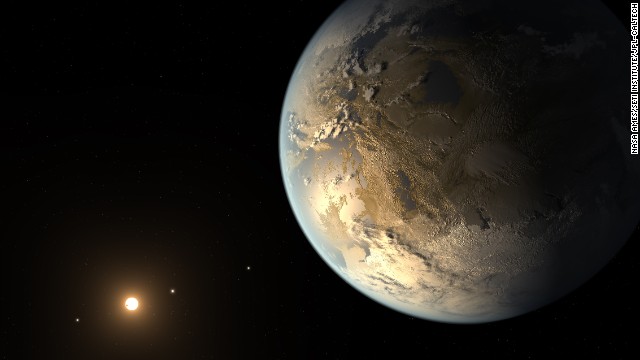
Scientists looking for signs of life in the universe -- as well as another planet like our own -- are a lot closer to their goal than people realize.
That was the consensus of
a panel on the search for life in the universe held at NASA
headquarters Monday in Washington. The discussion focused not only on
the philosophical question of whether we're alone in the universe but
also on the technological advances made in an effort to answer that
question.
"We believe we're very,
very close in terms of technology and science to actually finding the
other Earth and our chance to find signs of life on another world," said
Sara Seager, a MacArthur Fellow and professor of planetary science and
physics at the Massachusetts Institute of Technology.
"Finding Earth's twin,
that's kind of the holy grail," said John Grunsfeld, an astronaut who
helped repair the Hubble Space Telescope in 2009 and is now an associate
administrator at NASA.
Strides in the search for life
Scientists have made stellar strides in the past few years alone.
"We already know that our
galaxy has at least 100 billion planets, and we didn't know that five
years ago," said Matt Mountain, director of the Space Telescope Science
Institute in Maryland.
He credited the work of the Kepler Space Telescope for these new discoveries. The planet-hunting Kepler probe,
launched in 2009, finds planets by looking for dips in the brightness
of a star as a planet transits, or crosses, in front of that star.
Kepler also found the
first Earth-size planet that orbits in a star's habitable zone, the area
around a star where a planet could exist with liquid water on its
surface.
The Kepler mission
builds upon the stalwart Hubble Space Telescope, which launched in 1990
and was the first of its kind to be placed in space. As Hubble orbits
the Earth, it allows scientists to peer back in time, into distant
galaxies, and yields stunning images of the cosmos.
Hubble has helped shape our awareness of our planet's place in an ever-changing universe.
The Earth, though 4.5
billion years old, is a newcomer, said John Mather, senior project
scientist on NASA's next-generation James Webb Space Telescope. It's
only about one-third of the age of the universe.
And our galaxy is ever-evolving, with "about five or 10 new stars being born per year in our Milky Way," Mather said.
Planet hunters

The Kepler Space Telescope, launched in 2009, finds planets by
looking for dips in the brightness of stars as a planet crosses in
front.
Hubble's astounding views come from a vantage point only 353 miles above our Earth.
In comparison, the James
Webb telescope will be a whopping 930,000 miles from our planet. That's
close to four times the distance between the Earth and the moon.
Webb is set to launch in 2018.
Mountain, who is the
telescope scientist for Webb, said scientists now know where every
single star is within 200 light years of the Sun.
NASA's assembled panelists said, if they follow this map of stars, they're certain to find a multitude of new planets.

An artist's depiction of what the James Webb Space Telescope will look like.
"Every star in the sky
is a sun, and if our sun has planets, we naturally expect those other
stars to have planets also, and they do," said Seager. She said if
someone looked up at a starry sky and wondered how many of the stars
have planets, the answer would be "basically every single one."
Some of a star's light
will shine through the atmosphere, said Seager, and the Webb telescope
should be able to pick up gases from the planet that are imprinted on
the atmosphere. While the Webb telescope wasn't designed to find signs
of life on another planet, it can spot biosignature gases -- gases in
the atmosphere produced by life.
Seager said, with the
James Webb telescope, "we have our first chance, our first capability of
finding signs of life on another planet. Now nature just has to provide
for us."
Spotting Earths
Finding small planets,
ones the size of Earth, is challenging, in part because they produce
fainter signals, said Dave Gallagher, director for astronomy and physics
at NASA's Jet Propulsion Laboratory, who likened it to spotting a
firefly beside a searchlight.
That difficulty doesn't dull the hunt for another Earth or signs of life.
NASA administrator
Charles Bolden said he counts himself among the people who "are probably
convinced that it's highly improbable in the limitless vastness of the
universe that we humans stand alone."


0 comments:
Post a Comment